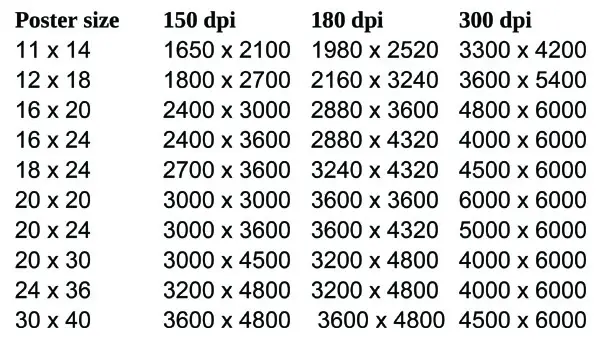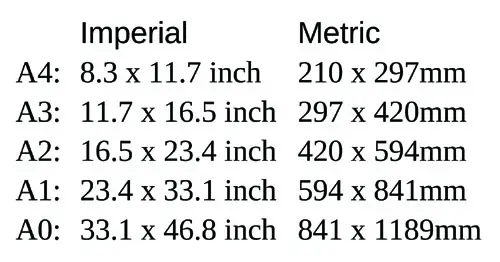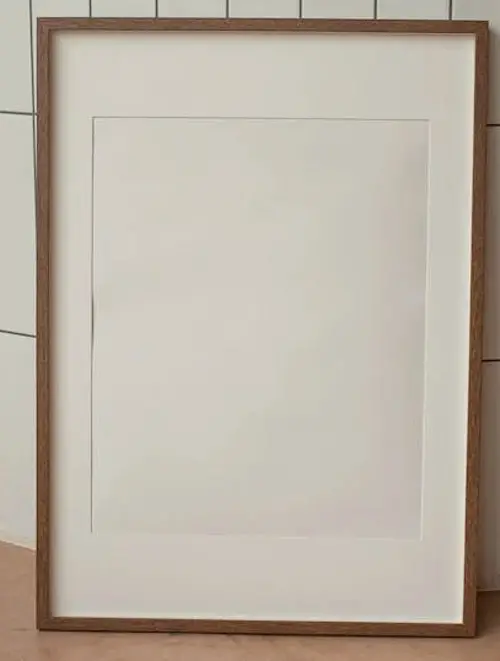A poster is a powerful tool for catching the attention of a passersby and conveying information. But before you think of how to create an effective poster, you need to understand the various sizes and framing options available that can help you communicate your message more effectively.

Whether you are looking to turn a photograph into a poster, or create a poster for a community event or business advertisement, this guide will help you find the perfect poster size and framing solution to match your style and needs.
Can You Turn Photos Into Posters?
You can turn photos into posters. There are several ways to do this, depending on your preferences and equipment. Here are a few options:
- Print at home: If you have a printer at home, you can print your photos on your own. Simply load your printer with photo paper, open the photo on your computer, and select “Print” (Ctrl+P). Next, adjust the print settings as needed, such as the size and quality of the print.
- Visit a local print shop: Many local print shops offer photo printing services, either through traditional printing methods or digital printing. You can bring in your digital photos on a memory card or USB drive, or you can scan physical photos and have them printed into posters.
- Use an online printing service: There are many online printing services that allow you to upload your photos and have them printed into posters and shipped to you. These services usually offer a variety of sizes and paper options, as well as extras like framing and mounting.
- Use a smartphone app: There are many apps you can use to resize your photos into your preferred poster size. Some of these apps use local printers, while others use online printing services.
Regardless of the method you choose, ensure you check the quality of your photos before printing them into posters if you want the best results.
Photos to Posters Essentials
When you need to turn a photograph into a poster, you have to consider several things, including whether the resolution of your original photo is enough for the size poster you want, whether you are scanning an old photo, deciding on portrait vs landscape orientation, whether you want to create a poster in an extended panoramic ratio, etc.
Orientation is a simple concept. Many wall posters from photos are landscape, however some are portrait to emphasize the height of a subject. Some posters are also square, but those require cropping from the original photo.
If you are scanning an old photo, the scanning resolution will determine how large of a poster you can create, similarly to the resolution of a digital image file. In addition, size of the original physical photo matters- if you have a wallet size photo, you will need to scan at a high resolution and it may still be too small to print a large poster.
Below is a useful table of best image resolutions in pixels for ten common poster sizes:

Keep in mind that a 16 megapixel camera can produce at maximum a 4920×3264 pixel photo, and a 24 megapixel camera a 6048×4032 pixel photo.
In terms of poster sizing specific to photography, you can use the following table which lists “A size” posters both in inches and millimeters, for those using the metric system:

Panoramic sizes include 18×36 inch, 12×24 inch, and 10×20 inch. Super panoramic sizes include 12×36 inch, 10×30 inch, 8×24 inch, 6×18 inch, and 5×15 inch. Ultra panoramic sizes include 8×32 inch, 6×24 inch, and 5×20 inch.
You can also use traditional poster sizes discussed below, which will fit more existing frames.

- Purpose of the poster – to choose the right size for your poster, you have to consider what you’ll use it for. Are you trying to communicate something specific? If so, what poster size can communicate your message exhaustively?
If your goal is simply to drive passerby’s attention to a product you’re launching, then a large format might be best. However, if your focus is on passing a small message (e.g. a memo to employees), smaller sizes might work better. In other words, large poster sizes are a good fit for product advertisements, while smaller formats are the best choice for informational content.
- Viewing distance – close-up posters are best for shorter viewing distances, medium-sized posters are best for medium-sized rooms, and large-sized ones work best in spacious rooms. Viewing space is the distance between the poster and the viewer. If you must use small posters for a longer viewing distance, backlit prints may be the best option because they’re sharper with improved visibility.
- Your budget – if you have plenty of money lying around or want to spend good money on a good poster, get yourself an enormous poster. But, if you’re on a tight budget, don’t go for a huge poster size. Although bigger is sometimes better, remember that every extra square inch costs money. If you want to save some cash and still get the job done right, choose a poster size that’s more manageable for your space and budget constraints.
Now, let’s discuss some of the most common poster sizes for photos, adverts, notices, and so forth.

8.5″ X 11″ Letter-Size Posters
8.5″x11″ posters are posters that are printed on paper that is 8.5 inches wide and 11 inches tall. If you need to turn photos or artwork into posters that you can hang on your walls, letter-size posters are the best and cheapest option. They’re also so close to the “A4” format (8.3”x11.7”) and you’ll find them mostly in schools, offices, stores, and public spaces.
One of the pros of 8.5″x11″ posters is their size, which is small enough to be portable and displayed anywhere, but large enough to convey a significant amount of information. They are also widely available and easy to find frames for, which makes them a convenient poster option. Another pro is that they are relatively inexpensive to print, which makes them a cost-effective option for businesses and organizations that need to produce many posters.
However, the size of 8.5″x11″ posters can limit you if you need to include detailed information or complex graphics. Additionally, 8.5″x11″ posters may not stand out compared to larger sizes — but you can use a backlit option of the same size if you want to be unique.
The Legal-Size Poster
The legal-size poster is 8.5 inches wide and 14 inches tall. This size is commonly referred to as “legal size” because it is the standard size for legal documents in the United States. Legal-size posters are slightly larger than 8.5″x11″ posters and offer more space for displaying information or graphics. They are often used in professional or legal settings, such as in law offices or government buildings. Like 8.5″x11″ posters, these posters and their frames are widely available.
Since legal-size posters are slightly larger than letter-size posters, they’re more noticeable. This also means they require more paper; that’s a con.
Bulletin Posters
11″ x 17″ posters are also known as “tabloid” posters because they are the same size as the tabloid newspaper format. The term “tabloid” originally referred to a compressed form of something, and in the case of posters, it refers to posters that are smaller than the standard newspaper size but larger than a typical flyer or brochure. So, while 11″ x 17″ posters are not the only posters that are referred to as “tabloid” posters, they are a common size for this type of poster.
The most notable feature of 11″ x 17″ posters is their large size, which makes them a great option for displaying information or advertising a product or event. They’re often more eye-catching than smaller posters and you can easily see them from a distance.
12” X 18” Mini Posters
Mini posters are small posters, often no larger than 12 x 18 inches, that you can use for many purposes. You can use them to promote a product, event, or idea, or to display photos or artwork. They’re also an excellent alternative where a large poster is impractical or where space is not enough, such as in a retail store, office, or dorm room.
Some potential benefits of mini posters include:
- You can display them in various locations and settings, including in small spaces where a large poster may not fit.
- They are a cost-effective way to promote a product, event, or idea.
- They can help to attract attention and draw people to your message or product.
- They can be a fun way to communicate complex or abstract ideas.
16” X 20” Posters
16 x 20 inches is a standard size for small posters. This size is also commonly used for art prints, photographs, and many other types of wall decor. It is a versatile size you can easily frame or hung, and this makes it a popular choice for both home and office spaces. The dimensions of 16 x 20 inches provide a good balance between displaying a lot of detail and keeping the poster size manageable.
18” X 24” Medium Posters
Medium posters are printed on medium-sized paper. The exact dimensions of a medium poster vary, but they are generally larger than small-sized posters and smaller than large posters; 18 X 24 inches is the most common medium poster.
()

发表回复